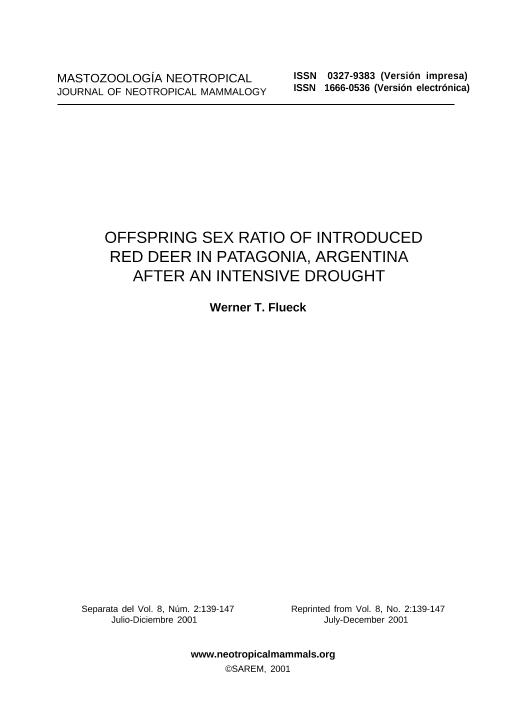Mostrar el registro sencillo del ítem
dc.contributor.author
Fluck, Werner Thomas

dc.date.available
2018-04-05T14:49:02Z
dc.date.issued
2001-12
dc.identifier.citation
Fluck, Werner Thomas; Offspring sex ratio of introduced red deer in Patagonia, Argentina after an intensive drought; Sociedad Argentina para el Estudio de los Mamíferos; Mastozoologia Neotropical; 8; 2; 12-2001; 139-147
dc.identifier.issn
0327-9383
dc.identifier.uri
http://hdl.handle.net/11336/40845
dc.description.abstract
Red deer (Cervus elaphus) introduced to Patagonia have reached high densities in the forest-steppe ecotone. Drought conditions during 1998/99 were suspected to impact subsequent reproductive performance. Necropsies of 50 adult females during winter 1999 revealed lowered pregnancy rates and lactation in 32% of non-pregnant as opposed to 0% among pregnant females. There were no signs of fetal resorptions or abortions. The fetal sex ratio (20m:8f) deviates significantly from unity, and mothers with female or male fetuses averaged 6,7 and 5,2 years, respectively (P=0.14). However, 90% of primiparous females (2,5 years old) had males, the following age class had all females, the middle age class (5-8 years old) had all males, and older females had equally male or female fetuses. These females were at borderline of body condition allowing conception and thus were at extremely low levels of condition during breeding. The male-biased fetal sex ratio contrasts reports of other studies that only females in best condition tend to have male-biased offspring. However, ambivalent results from other studies may stem from not having evaluated body fat reserves and reproductive tracts, or studies done during environmental conditions not extreme enough. The present results also indicate that red deer populations occur at densities where they can easily become food-limited through a singular environmental phenomenon such as a drought. Although recruitment rates would be drastically reduced through such temporary food shortage, red deer will recuperate rapidly and will continue to exert intensive pressure on the flora causing subsequent damage if population densities are not lowered through hunting.
dc.format
application/pdf
dc.language.iso
eng
dc.publisher
Sociedad Argentina para el Estudio de los Mamíferos
dc.rights
info:eu-repo/semantics/openAccess
dc.rights.uri
https://creativecommons.org/licenses/by-nc-sa/2.5/ar/
dc.subject
Cervus Elaphus
dc.subject.classification
Otras Ciencias Biológicas

dc.subject.classification
Ciencias Biológicas

dc.subject.classification
CIENCIAS NATURALES Y EXACTAS

dc.title
Offspring sex ratio of introduced red deer in Patagonia, Argentina after an intensive drought
dc.type
info:eu-repo/semantics/article
dc.type
info:ar-repo/semantics/artículo
dc.type
info:eu-repo/semantics/publishedVersion
dc.date.updated
2018-03-16T14:30:03Z
dc.identifier.eissn
1666-0536
dc.journal.volume
8
dc.journal.number
2
dc.journal.pagination
139-147
dc.journal.pais
Argentina

dc.description.fil
Fil: Fluck, Werner Thomas. Consejo Nacional de Investigaciones Científicas y Técnicas; Argentina
dc.journal.title
Mastozoologia Neotropical
dc.relation.alternativeid
info:eu-repo/semantics/altIdentifier/url/http://www.sarem.org.ar/wp-content/uploads/2012/11/SAREM_MastNeotrop_8-2_04_Flueck.pdf
Archivos asociados
